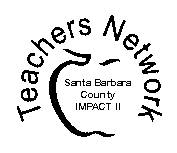Teachnet, sponsored with major funding by the AT&T Learning Network,
seeks to improve student achievement by providing training, grants, networking and resource sharing to teachers at seven of the Teachers Network affiliates nationwide.

Funding Provided by Alias Wavefront
Soda Machines
Soda
Machines- Engineering and Inquiry
How it Works:
I have slowly grown a set of Mac computers in the
classroom from 1 (which ran a FirstClass BBS for interschool
weather data sharing) to a mix of 9 older and new machines, all
accessing the internet via T1 line, and 3 having digital video
input and editing capabilities. Students sit in groups of 4 at
lab tables... no desks, and it is very common for individuals to
go to a computer to input a bit of data or writing to a piece of
work or class template and then return to the group.
However, I find that using hands-on learning with
higher level text and internet based learning gives students
room to grow, and I get a chance to learn more about their
individual styles and strengths.
This unit combines math skills for scaling and
measurement, visualizing and drawing 3 dimensional models, units
scientific inquiry process skills, and concise use of language
to explain design elements.
Standards
Standards addressed (California)
English Language Arts- 2.5 Deliver presentations on
problems and
solutions:
a. Theorize on the causes and effects of each problem and
establish
connections between the defined problem
and at least one solution.
b. Offer persuasive evidence to validate the definition of the
problem
and the proposed solutions.
Math-5th grade: 2.3 Visualize and draw two-dimensional
views of
three-dimensional objects made from rectangular solids.
6th grade: 2.0
Students identify and describe the properties of two-dimensional
figures. Use proportions to solve problems
Art-Artistic Perception: 1.2 Identify and
describe scale (proportion) as
applied to two-dimensional and three-dimensional works of art.
2.2=Use different forms of perspective to show the illusion of
depth on a two-dimensional surface.
Science-3: Heat moves in a predictable flow from warmer objects to cooler objects until all the objects are at the same temperature. (standards a-d all can apply depending on your choices for extensions) Also, Investigation &
Experimentation Standards: Recognize
whether evidence is consistent with a proposed explanation.
Estimated
Class periods to Complete
6-8 50 min. periods
Software or materials used
At least one computer that can access the internet and
display material
on tv or screen. Ideally, the students have access to several
computers
or a lab for at least 2 periods.
The Students -
My middle school program is a mix of science and
English Language Development(around 90% of our students have
English as their second
language). There is no reason to let language limitations result
in low levels of cognitive enthusiasm, and I've found over the
years that
regular access to a range of hands-on activities, along with
technologies- from computers to hand held sensors, still shots
to
video-bring out the best in most students
Overall Value-
ELD students, especially by jr. high, usually are
getting very
frustrated because of mismatch between cognitive age and
academic
English language abilities. This type of activity gives them
more access
to constructivist learning, mixtures of graphics and text to
convey meaning, and skills with digital resources. They have
some freedom toselect what works best for their problem
solutions
Tips for teacher-
Don't be in a hurry!
It seems too rare that we can get students working out their own
ideas
in ways that allow us to spend individualized time listening to
them
work through new thinking. Also, for some the drawing skills are
a big
jump, but worth the effort when they find out they too can
represent 3
dimensional visions on paper.
Jeff Foote has been a science and English Language
Development teacher at a jr. high school for 10 years. He
administrated a FirstClass electronic bulletin board system (bbs)
for science teachers and students. Science data, photos, student
work samples and challenge
questions ran through the system. A key element was the ability
to archive shared work. Since that participation, he's been a
district and
county schools tech mentor for numerous years, state leadership
team member for online science resources, and been directing
staff
development projects in science, English Language development,
and technology. Current projects include piloting LessonLab,
online videotape analysis tool for teacher instruction,TQ2- a
national e-mentoring pilot, and Beyond the Classroom, another
NSF project helping
teachers integrate science, language, and technology standards
into units of instruction.
